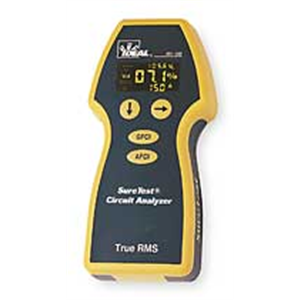What are AFCIs?
Arc-fault circuit interrupters (AFCIs) are special types of electrical receptacles (or outlets) and circuit breakers designed to detect and respond to potentially dangerous electrical arcs in home branch wiring.

What are AFCI testers or indicators?
AFCI tester indicators (sometimes called AFCI testers) are portable devices designed to test AFCI functionality. They create waveform patterns similar to those produced by actual arc faults, thereby causing working AFCIs to trip. AFCI indicators are considerably larger and more expensive (by several hundred dollars) than ground-fault circuit interrupter (GFCI) indicators and are of questionable effectiveness. For these reasons, they are not used as widely as GFCI indicators.
Why are AFCI indicators important?
While an AFCI circuit breaker comes with a test button that performs a role similar to a portable AFCI indicator, this button cannot test for arc faults within individual portions of the branch circuit. An AFCI indicator, however, can test any individual receptacle within the branch. InterNACHI inspectors should use AFCI indicators to inspect receptacles observed and deemed to be AFCI-protected.
How do they work?
AFCI indicators should be inserted directly into the receptacle. Some AFCI indicators, such as the popular #61-165 model produced by Ideal™, offer a number of testing options. This indicator creates eight to 12 pulses of 106 to 141 amp charges in less than a second which should be recognized by the AFCI as a dangerous arc and cause it to open the circuit that it serves. The indicator can also test for nuisance tripping, the annoying tendency of an AFCI to open its circuit when it detects a safe, shared neutral connection. For this test, it produces a 300mA arc that should not cause the AFCI to trip. Some AFCI indicators conveniently incorporate a GFCI indicator into their design.
AFCI indicators are somewhat larger than GFCI indicators but they are operated in the same way. An inspector simply inserts one into a receptacle and navigates the menu in order to produce the desired electric current. The user will know that the circuit in question has been tripped if the AFCI device loses power. If this occurs following an AFCI test, the AFCI is functioning properly. The user should then go to the electrical panel to reset the AFCI breaker. If the test results in the failure of an AFCI breaker to open the circuit, then a qualified electrician should be contacted.
How effective are they?
It is important to understand the distinction between an AFCI indicator and the test button on an AFCI device. The latter produces an actual arc fault and can be relied upon to assess the functionality of the AFCI. An indicator, by contrast, creates waveforms that are not true arcs but are characteristic of them and are thus not a completely reliable measure of an AFCI’s functionality. As a result of this distinction, an indicator might not cause a perfectly functional AFCI to trip. Although commonly called testers, it is more appropriate to refer to them as indicators, despite terminology that often appears in AFCI “tester” user guides.
Underwriters Laboratories, a product-testing organization that develops product standards, requires AFCI indicators to include the following information detailing this limitation in their product manuals:
CAUTION: AFCIs recognize characteristics unique to arcing, and AFCI indicators produce characteristics that mimic some forms of arcing. Because of this, the indicator may give a false indication that the AFCI is not functioning properly. If this occurs, recheck the operation of the AFCI using the test and reset buttons. The AFCI button test function will demonstrate proper operation.
This caution implies that an AFCI is working properly if the indicator causes it to trip, but the reverse is not necessarily true. An AFCI that does not trip as a result of an indicator may actually be perfectly fine. The test button on the circuit interrupter can be used to confirm its malfunction in the event that the indicator does not cause it to trip. Manufacturers claim that their AFCI indicators provide a universal method to test AFCIs that are produced by different companies.
In summary, AFCI indicators help ensure that AFCIs are properly monitoring the circuits that they serve for dangerous arc faults. These devices create electrical waveforms characteristic of those produced by an actual arc. As their effectiveness has been debated, they should be viewed as a complement to the test button on an AFCI, rather than a substitute.

Signature Inspections Hawaii, LLC, is FULLY Insured & “NATIONALLY CERTIFIED” by InterNACHI. InterNACHI also requires inspectors to continue their education through accredited courses, conferences, online learning, etc… and annual Inspector Certificate Testing in order to hold a current certificate.
808.388.3425
Trevor Drinen | CPI Certified Professional Inspector # NACHI16122702
*For a more detailed explanation of the inspection process please feel free to visit: InterNACHI Residential Standards Of Practice and InterNACHI Code Of Ethics .










